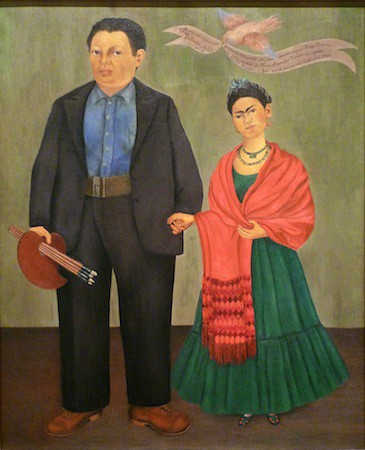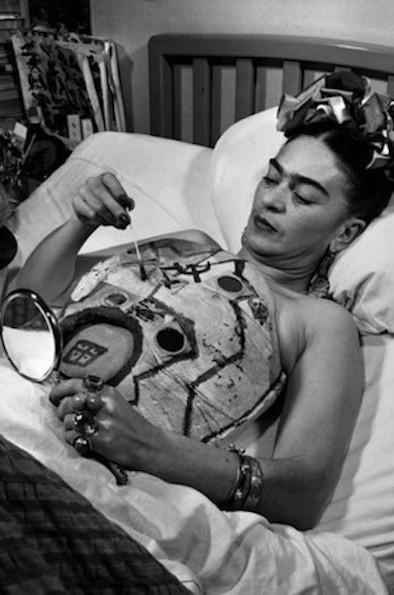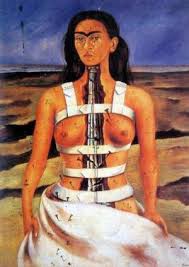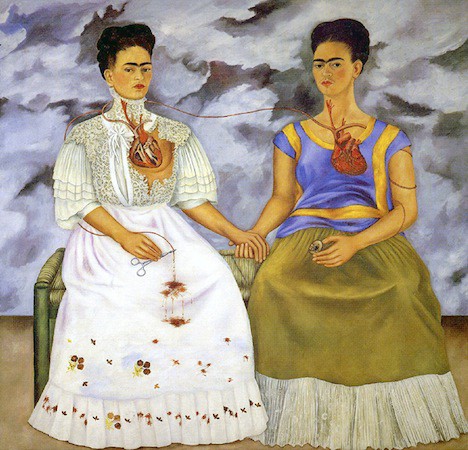At the age of 18, Frida Kahlo was injured in a bus accident which sent a handrail through her back and out of her pelvis. The crash crushed her foot and dislocated her shoulder. Her collarbone, two ribs, and one leg were broken. But the most detrimental injuries were to her spine and pelvis. Both were broken in three separate places.
This body altering event led to a life of surgeries, recoveries, and pain. She became an alcoholic, an adulterer (like her husband), and a masterful painter. Her horrible physical condition became the inspiration for her morbid and macabre paintings. She used her own troubles as inspiration because ?[she] was [her] own muse. [she] is the subject [she] knew best??. Kahlo?s pain created works focusing on the death, decay, and brokenness of the human body.
Kahlo first met Diego Rivera, a Mexican muralist, in the National Preparatory School in Mexico City. She was a student and he was commissioned to paint a mural for the school. The two married in 1929 even though they were 20 years apart in age.
 ?Frida and Diego Rivera?, 1931
?Frida and Diego Rivera?, 1931
Rivera described Kahlo as ??the most wonderful part of my life?. While this may have been true, it did not stop him from having multiple affairs. The two were like fire and gasoline, or as her parents put it, ?an elephant and a dove?. The troublesome relationship caused the pair to divorce in 1939 (only to remarry a year later). They also had trouble conceiving a child, and when she finally became pregnant, she lost the baby. The constant ups and downs of their relationship added to Kahlo?s sometimes pessimistic and sad painting subjects.
The first piece that exhibits her focus on dark themes is the work titled ?The Henry Ford Hospital?. The painting shows a nude Kahlo in bed with a fetus, a snail, and a human abdomen floating above her. The three connect to her via umbilical cords. The snail represents the agonizingly long time it took for Kahlo to get pregnant. The abdomen reflects her traitorous womb and how it was unable to nurture the floating child.
 ?Henry Ford Hospital?, 1932
?Henry Ford Hospital?, 1932
Throughout her entire life, Kahlo endured multiple surgeries trying to fix her broken bones. One of these included medically re-breaking her spine to set it in the proper position. She spent long periods of time bedridden and in casts. One of her first works is actually her plaster torso cast on which she doodled while she healed. Another operation was towards the end of her life when her leg became infected with gangrene. It was amputated at the knee.
 Kahlo painting her cast
Kahlo painting her cast
The piece titled ?The Broken Column? shows her lifelong connection with the brokenness of the human body. The painting shows Kahlo in a leather and metal back brace similar to the one worn to correct her spine. Her chest is split open to reveal her backbone, here represented by an ionic column. The stone is cracked in multiple spots reflecting her broken back. Kahlo illustrated her pain with tears flowing from her eyes and with nails embedded in her skin.
 ?The Broken Column?, 1944
?The Broken Column?, 1944
Kahlo seemed to go through more than what most people would consider possible. She lived an entire adult life in emotional and physical suffering with a marriage to a sexually unfaithful man. She put her pain perfectly with; ?At the end of the day, we can endure much more than we think we can?. She found enough strength in her pain to keep on going.
In 1940, Rivera and Kahlo divorced, at his request. While they did get back together eventually, the divorce was hard on her. She channeled her emotions, just like she did with her physical pain, into many of her most successful paintings. She resorted to liquor to solve her problems. After finally cleansing herself of alcoholism, she stated: ?I tried to drown my troubles in alcohol, but the bastards learned how to swim?. Kahlo finally woke up and realized something; tequila and brandy weren?t going to solve her issues.
While in between her marriages to Diego, Kahlo took her emotional struggles and put them into art. One of her most famous works is ?The Two Fridas?, a painting with two self-portraits holding hands. One is in a formal Victorian dress while the other is in traditional Mexican attire. The European Frida shows no emotion, even when her heart is exposed to the viewer. The Mexican Frida shows sadness and is slouching like her troubles are holding her down. While in Paris on an exhibition, Kahlo felt the Europeans showed no emotions, like heartless machines. She wished she could be like the women of Europe. She wished she could just bottle up her emotions, bear her heart, and still hold her head up. But she was the Mexican Frida; sad and heavenly burdened.
 ?The Two Fridas?, 1939
?The Two Fridas?, 1939
One of Kahlo?s more death-oriented pieces is named the ?The Floating Bed?. The painting shows a sleeping artist being watched by a skeleton. The bones are covered in fireworks, ready to go off at any second. Kahlo is covered with injuries and ready to die any second. Although this is a depiction of death, it is not one of ?doom and gloom?. It is one that mirrors the Mexican Day of the Dead. Here, death is being celebrated. If it comes to all of us, we might as well embrace it. The skeleton could also represent Kahlo?s soul, ready to float off. The sleeping figure is happy and peaceful, embracing the last day she knows will come. In reference to her dying, Kahlo wanted ??the exit to be joyful, and I hope never to return?.
 ?The Bed?, 1940
?The Bed?, 1940
Even though she passed over six decades ago, Frida still captivates the world. Her work largely revolved around death and bodily decay, two very real things to her. Dying and decay obviously still occur today, and as long as they do Frida Kahlo will be relevant. People tend to like what they can relate to or see themselves in. Everyone knows death is coming and Kahlo expertly illustrates this knowledge. She has depicted one of the most natural occurrences in the world, and she will be remembered for it.
Frida Kahlo-Rivera was tortured every day she drew breath. She was constantly in pain and ?death danced around [her] bed at night?. The thought of dying loomed constantly. Instead of fearing it, she embraced death as a muse. Kahlo took the pain caused by brokenness and death and transformed it into works of art. These pieces create a window into her troubled life and show that inspiration can come from even the hardest of situations.


